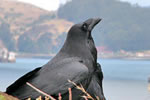Description |
The American Kestrel is our smallest and most widespread falcon. Like many Pennsylvania birdwatchers, my first experiences with the American Kestrel occurred along the telephone wires lining the fields in central Pennsylvania along the Pennsylvania Turnpike. Though it was often difficult to catch a lasting glimpse of this colorful raptor at 55 miles per hour, the tell-tale posture and silhouette of the bird made it easy to identify. Measuring about 10 inches in length, the American Kestrel has a blue-gray cap that surrounds a rufous circle, black markings about the face and neck, a rufous back with black markings, blue-gray wings with black markings, buff colored breast and underparts with black markings, and a rufous tail fringed with black and a white terminal band. Females are similar but have brown wings. Kestrels are the only falcons known to nest in man-made nesting boxes. |
Diet |
| Kestrels eat a variety of insects, rodents and small birds and usually hunt from an exposed perch. Kestrels capture prey by hovering (almost tern-like) before diving onto it from above. |
Habitat |
| While Kestrels are generally birds of open areas, pastures, fields, and farmlands, they are frequently found in urban areas with suitable habitat. |
Range |
| American Kestrels range throughout North America and into South America, with highest densities occurring in the western Great Plains of Wyoming and Montana. |
Status |
| The American Kestrel is common, but like many birds of the grasslands, its numbers are declining through much of its range at an alarming rate. |
 |
 |
 |
 |
 |
 |
 |
 |
 |
 |
 |
 |
 |
 |
 |